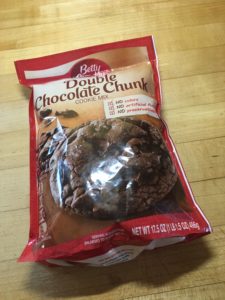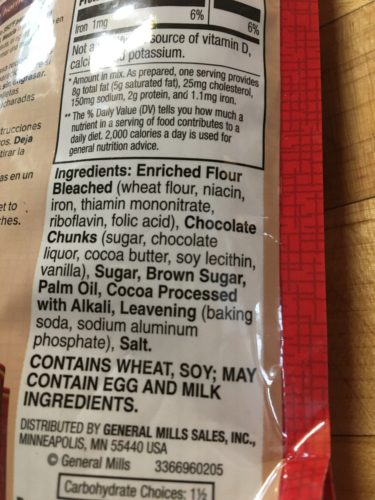So I’ve got a conflict to toss around. Sort of. Not the “difficult conversation” type conflict I’ve been so focused on of late. — or rather had been before my attention zoomed over to COVID. (Zoomed, you get it? Sorry).
This one is more a conflict within myself. Another who-do-I-believe? conflict. And it has to do with . . .
Food
What’s healthy? What’s the right product to buy or eat or boycott?
I’ve found that, too often, because the guidelines keep shifting, how I sort it out is exhausting. (Not unlike my current love-hate relationship with Facebook, but that’s for another time).
Here’s my story.
Two-fifths of my Ohio-based grandchildren and their parents came to visit over President’s Day weekend and I did a little shopping ahead of time. In among all the fruits and veggies, I thought it’d be fun to make cookies.
I had chocolate chips (organic) in my pantry at home, but I didn’t have my favorite Toll House cookie recipe, so I swept down that aisle and grabbed a bag, for the recipe only, and tossed it into my cart.
Then, I saw a package for making chocolate chocolate-chip cookies super easy. What chocolate-loving grandkid human being wouldn’t love it!
Here it is on my kitchen counter.

I don’t generally buy packaged food. I shop the perimeter, you know, where the healthy stuff is. But this was a special occasion.
I was thinking of the fun exercise it would offer the three of us. Besides, it called for my own stick of butter and an egg. That’s half-way to slow cooked cookies, I figured. And, it made sure I understood that it contained no colors, no artificial flavors, and no preservatives. See the big notice there on the front?
Into the cart it went, along side the Toll House package.
We never made cookies that weekend. There was simply no down time and so the package sat in my cabinet. I took it down the other day a few weeks ago in preparation for a visit from their older brother, Mikah, who’s working in nearby Stowe this winter. It was only then that I read the label more carefully.
What do you notice?

Palm oil jumped out at me and my heart sank.
Palm oil is bad, I’d learned at some time and place; though I now have no idea when or where. “No Palm Oil” has been part of my shopping credo for years.
But why?
Why I was staying away from palm oil I couldn’t really say, only that people I liked stayed away from it.
Was it unhealthy or was there some other reason? If the contents of my cookie package was destined to go to my chickens, I wanted to at least understand why.
So, I turned to Google, purveyor of all things superficial. Sure enough, there I found enough reading material to fill a small library:
Top Ten Facts You Need to Know About Palm Oil,
Nine facts you (probably) didn’t know about palm oil,
Eight Things To Know About Palm Oil,
The Truth About Palm Oil: The Dark Side You Probably Don’t Know and
countless others. Far too many to list.
Here’s the problem with palm oil, I discovered. And it wasn’t health.
Cardiovascular issues seem to no longer be a concern. Sure, palm oil’s very high in saturated fat content. But, it also contains antioxidants and, when combined with a balanced diet, the high fat content, they tended to cancel each other out.
No, the problem was bigger than clogged arteries.
It was the impact on the environment that presented the most frequent complaint against palm oil use. Deforestation in particular. The loss of needed habitat for countless animals, as huge swaths of forest were clear cut, has orangutans suffering the most (100,000 lost between 2002 and 2018). But other animals are also affected. Local indigenous communities are uprooted. Climate change is exacerbated. Lots of environmental problems.
Further reading revealed that we’re not doing away with palm oil. Ever. It’s here to stay as the world population is ever increasing. Turning to other sources of oil, I read, will only mean even more land will need to be cleared. Sustainable harvesting is the answer.
There is now a Roundtable on Sustainable Palm Oil (RSPO) and companies (buyers of palm oil, specifically) can join and get a score that will enable consumers to have some insight as to the company’s overall culpability. That’s the theory.
The World Wide Fund for Nature (the group with the panda bear logo that automatically sends return address stickers ad infinitum) offers a palm oil buyers score card to measure how various companies fare in that regard. I linked to it just then.
Who knew?
So, I typed in Betty Crocker, clicked on their parent company, General Mills, and learned that in 2019 General Mills had a score of around 12 out of a possible 22. AND, they’ve made a commitment to do better by 2020.
For more details on how the WWF arrives at the scores, see this link.
Anyway, I made Mikah the cookies his sisters never had a chance to enjoy.
And they were delicious. And he took home all the left over ones.
How about you? Do you read labels? Anything you try to stay away from? How do you get your information?

P.S. for those of you aware of my sugar journey, I’ll just say I continue to be a work in progress.
[box] LEAPFROG, my tiny handbook for handling those tricky conversations we all face, available in digital and paperback format, will soon have an audiobook version. Stay tuned.

I’m participating in Amazon Affiliates, so your purchase through my website will enable me to make a wee bit more and not increase your cost at all. The above link takes you to the LEAPFROG page on my website (not yet accessible directly) where you can learn more about the book. To skip that page and go directly to the book’s page on Amazon, click here. Thank you.
[/box]
Cheryl
Hi Janet, thanks for the informative post. I’ve also been an ‘avoider’ of palm oil for some time. You’re right, ‘farming’ it is creating a huge environmental problem. I don’t often buy processed foods, but when I do I read labels and reject the products that I’m not prepared to ingest. We cook fresh foods every day, or prepare them raw for salads. I’m still off the sugar and chocolate (about 6 weeks) and feeling very good right now! Thanks again for this, it’s really important information for people to know.

Cheryl recently posted…Hot Water Blues
Janet Givens
What stood out for me, Cheryl, was that ALL OILS require clearing the land to some extent. And the problem is really one of a growing world-wide population and the demand for oil in our diet. So much is connected to so much. We are solidly in the slow food world, easy to do actually where we live. Good farms all around us. I think this jumped out at me only because I’d bought this package on a whim. But Mikah was most appreciative. Glad you are still on your sugar-free journey. I’ve stepped off that train for the moment. Will see what the future holds.
Janet Givens recently posted…Conflict in the food we eat
Cheryl
Hi Janet, all food requires clearing the land to some extent! I don’t use a lot of oils or butter. I tend to get my oils from foods like avocado, olives and nuts. As we’re currently not able to move (travel), and having lost our jobs in Russia, I’m using all this free time I have to try and learn more about food, health, and how our bodies work. It’s very interesting, and I believe it’s never too late to start making changes in diet and lifestyl! Have a great day, Janet!
Marian
Short answer, I do read labels but sometimes succumb to items that aren’t particularly good for us in the interest of ________?_________. It can’t be time; I have plenty of it now.
Recently, I picked up a bag of chili “mix,” the kind where you just add onions or other condiments. Hubby said there was enough gas in the mix to propel a small lawnmower. Chili beans often cause flatulence anyway, but this was way, way beyond, so he said!
I admire all your research here, but you thrive on that.
Janet Givens
I know what you mean, Marian. I think “slow cooking” — everything from scratch becomes a life style after awhile. And one that can feel daunting from beyond. Woody loves to cook, so he’s really the impetus for it. But wow, does slow cooking ever lead to lots of pots and pans afterward (that’s my job). I love Cliff’s sense of humor.
Janet Givens recently posted…Conflict in the food we eat
Arlene Smith
I’m a “listen to my body” kind of eater. Our bodies know! When possible I buy locally sourced items with little processing, but I allow room for forgiveness when that isn’t possible or when a little indulgence is required.
Janet Givens
Aren’t we lucky to have locally sourced items. So many these days don’t. “Room for forgiveness” — I love it. Reminds me of an old favorite: it’s easier to get forgiveness than permission. Not really applicable here, I guess; but a fun one. Here’s to a little indulgence for us all. Thanks for stopping.
Janet Givens recently posted…Conflict in the food we eat
susan scott
Thanks Janet, the message re palm oil can’t be overstressed. I am a label reader even if I have to squint like mad as usually the type is tiny. NOT buying goods made with palm oil is a fair way of protesting. It seems to be an essential ingredient for flavour, things lasting longer etc but no thanks. Not when I know the damage of deforestation and eg orang-utans and the livelihoods of people. Though I’ve fallen through the cracks many a time … I look out for labels that say responsible/sustainable palm oil ..
Janet Givens
You know, Susan, that package was the first I’ve bought in a few decades. So, I don’t usually come across many labels that need to be read. AND, since then I’ve bought six packages of chocolate brownie mix! I thought a taste test would be a good way to pass the time. It’s gotten way too easy for me to go down that path. Thanks for the reminder to check that “sustainable palm oil”
Janet Givens recently posted…Conflict in the food we eat
Terri Lyon
I appreciate your commitment to a better environment, Janet.
Terri Lyon recently posted…Teach Your Child to Be an Activist
Janet Givens
Thank you Terri. And I yours.
Janet Givens recently posted…Conflict in the food we eat
Laurie Buchanan
Janet — I never fail to learn something in your weekly posts. Len and I rarely buy processed food, but when we do, we’re label readers. One of the things we never (ever) buy is anything that says Conagra (famous for genetically modified crops/food). You might be surprised to learn the broad reach of their brands — including the very misleading name “Healthy Choice.”
Janet Givens
Very good point, Laurie. Thank you. These food marketers are so good at phrasing their product for the times. Seems like they were the early days of “faux news.” I never heard of Conagra. I’ll keep an eye out, though it probably doesn’t bother to sell here in Vermont. We’re a pretty food conscious bunch up here.
Janet Givens recently posted…Conflict in the food we eat
Joan
I always read labels and rarely buy processed food unless it’s an emergency. I believe we should eat and cook the way our grandmothers did. Eat as many fresh, organic fruits and vegetables as possible and only pasture raised, grass fed meats. We try to eat some fresh fish every week, chicken, turkey, but rarely beef. At least half of our meals every week are vegetarian.
We are lucky to live in a food conscious part of the world with many local farms. We have a local food hub that gives us two drive through markets a week. We’ve been enjoying locally grown lettuces, micro greens, spinach, kale, cauliflower, carrots and strawberries. Such a delicious time of the year. I’m looking forward to locally grown tomatoes, peaches, and eggplant coming soon.
Janet Givens
A delicious time of the year. I love that, Joan. And it is indeed.
Janet Givens recently posted…Conflict in the food we eat
Darlene Foster
I read the labels as I’m a vegetarian and need to know if there is any animal fat in anything. Also, my son is allergic to nuts. I bake most things from scratch, especially now that I’m retired. But occasionally I’ll use a mix. Try to stay away from palm oil due to environmental issues. I prefer olive oil, olives grow in abundance here in Spain and don’t take away any habitats. Often people make their own oil. Food for thought!!
Darlene Foster recently posted…The Indie Showcase presents, Darlene Foster
Janet Givens
However does one make their own oil, Darlene? Any chance the average American (like me) could do that? I’d love it. I imagine it takes much pressure. Your setting, amidst ancient olive groves, sounds delightfully romantic.
Janet Givens recently posted…Conflict in the food we eat
Darlene Foster
They would have an olive press, or pick their olives and take them to a place that has a press and pay them to press it for them. My cousin (distant) lives on a 300-year-old finca with the original olive press that would have been operated by donkeys. How cool is that! It hasn’t been used for some time of course. Or you could make your own press https://ourpastimes.com/how-6673045-build-olive-oil-press.html
Janet Givens
That is very cool. The image I have in my head of an olive press was of an apple press writ small, until I checked out the link you gave. It’s more like the first few steps when I make apple jelly. Very cool. Too bad olives need such a warm climate; I’d consider adding them to our orchard.
Janet Givens recently posted…Musing In The Time of CoViD: Measurement
Ally Bean
Excellent discussion. I read labels with an eye to making sure the ingredients in the food are as few and as real as possible. I find that when it comes to sweets, baked or mixes or sometimes candy, there’s often something unsavory lurking in the product like the Palm Oil or weird sweetners like aspartame. Eating healthy seems like it should be straightforward, but it rarely is. Still I try.
Ally Bean recently posted…While Spring Rain Falls, Musing On How I Feel Now
Janet Givens
Yes. Did you ever hear that adage about not buying anything where the label (1) has more than five ingredients and (2) contains words you can’t pronounce.
So simple. My new thing is staying away from anything with high fructose corn syrup.
Janet Givens recently posted…Conflict in the food we eat
Kathleen Pooler
Thanks for another informative post, Janet. I do read labels and have avoided Palm Oils for years in attempt to eat healthy. It was easy when Wayne gardened and we ate fresh produce but alas, those days are over.
Janet Givens
I’m sure that was hard on Wayne. Farming was such a part of his identity. It’s a good thing we all have multiple identities, huh? Woody gave up one of his gardens this year — the one on the side of a hill. Obvious reasons; he is 81. And, we agreed we’d buy more from our various local farmer’s markets. Can you two get out and about yet? Do you know when you’ll be able to drive again? That’d help me get through all the cumbersome PT visits. Thanks for stopping by, Kathy. Always good to hear from you.
Janet Givens recently posted…Conflict in the food we eat
Bette Stevens
Yes, I read labels. Hubby and I both have heart issues. I make most of our meals and goodies from scratch–‘unadulterated’ is what I tell Hubby. Palm oil is a ‘no no’ here at the farmstead. I use canola oil, olive oil, butter and occasionally lard. We enjoyed our first taste of asparagus from the garden today. For two weeks, it’s been salads and steamed greens a la dandelions! I made Toll House cookies last week and this week will be oatmeal raisin. <3 Happy and healthy cooking and eating! xo
Janet Givens
I envy you your asparagus, Better. You’re in Maine, yes? My asparagus is just now popping up; about 1″ showing I think. I must take a closer look. How can mine be so very far behind yours? You must be by the water and it’s a bit warmer? I’m at 1800 feet and just an hour south of Canada.
I love that you pop in those cookies and I thank you for that; I feel a bit less self-indulgent now. Isn’t that Toll House cookie recipe the best? I’ve yet to find a better chocolate chip recipe.
Janet Givens recently posted…Conflict in the food we eat
Pamela Wight
Oh boy. You educate us all in so many ways. And now with palm oil. I have studiously avoided palm oil (and yes, I always read the labels) but I admit, I didn’t really know why. The answer is worse than I would have guessed. I try to make everything ‘from scratch,’ because then I generally know what I’m putting into my recipe and my mouth. I’m a firm believer in chocolate chip cookies ‘from scratch’ with my own sticks of (yup, organic) butter, sugar, flour, organic range-free eggs, and Guittards chocolate chips (expensive but worth it). I am a chocolate chip cookie snob. But I make them so my grandkids will love me into eternity. (another joke…kind of). xo
But I make them so my grandkids will love me into eternity. (another joke…kind of). xo
Pamela Wight recently posted…Mother May I
Janet Givens
Might you share your cookie recipe at some point, Pam? Perhaps a blog post out of it? Those of us with an unrestrained cocoa addiction would be truly grateful. Your grandkids are indeed a lucky bunch. Thanks for swinging by.
Janet Givens recently posted…Conflict in the food we eat
Pamela Wight
Ummm, seriously, I just use the recipe on the back side of the Guittard (or Nestle) Chocolate Chip bag (it says “the original Toll House recipe”). But I add a HUGE amount of ingredient not listed there……. L O V E.
Pamela Wight recently posted…Her Only Choice
Janet Givens
Indeed, that Nestle Toll House recipe is classic. I never heard of Guittard. And your final ingredient — oh yes. That’s the best.

Janet Givens recently posted…Conflict in the food we eat
Tim Fearnside
Hi Janet, our household has one daughter with several food allergies, two (both) who don’t eat meat, a super health-conscious spouse who is “pescatarian,” and a couple of liberal do-gooder parents (that’s where I enter) who are interested in minimizing our harm to the planet. So, yes – lots of label reading around here! (And, as at least one other mentioned, lots of dishes! (Again, my department). It’s interesting (and frustrating) that eating healthy/organic/local/even vegetarian costs so much more than the alternative. On a positive note, the garden has survived a week of rain, and is looking pretty good. We’re swimming in greens!
Janet Givens
Wow, I’d need a computer program, I think, to keep track of all the needs there, Tim. So, kudos to you. Organic and local does so often look more expensive. I like to factor in the hidden costs of the alternatives though — the carbon footprint to traipse the stuff often across the country, and all that implies. I think Americans got wooed into thinking food “should” be cheap. The push for coupons in the 50s, 60s, et al, seems to me, got it into our heads that the less we paid for food, the better. So, a bit of education might go a long way. But by whom? Big business has had more influence in our lives than I think most of us suspected along the way. We’re at the tail end of an extended dry spell up here. And hot. Two weeks ago, we had snow; yesterday it was nearing 80 degrees. It’s as though we just skipped right over spring. Crazy times.
Janet Givens recently posted…Conflict in the food we eat
Tim Fearnside
You’re absolutely right – there are real costs to not eating local/organic, etc. – and they’re not at all insignificant. A big part of the problem, I think, is that we subsidize all the wrong things. As you state, big business… If we (as a nation) wanted to do what was best for our planet (not to mention, small and middle class farmers), we would subsidize vegetables, local and organic produce, and the like. It’s absurd that a Big Mac costs less than an organic head of lettuce…
Janet Givens
Agree with it all, Tim, thoughI can’t help but smile at the idea of a political campaign ad advocating subsidizing vegetables. Just imagine the backlash!
Janet Givens recently posted…Musing In The Time of CoViD: Measurement
Jenny C.
Interesting & informative post, as always!
I think farming of anything should be done with proper respect and concern for the environment. I’ve generally leaned towards using olive oil but I have no idea what type of farming is practiced in that industry!
I’ve also started using more coconut oil, since it’s supposed to be healthier. However, I now wonder how different coconut oil production is from palm oil production with respect to environmental concerns. It seems to me that such tree farms would look pretty much the same!
Jenny C. recently posted…Cuba’s national flower: Celia Sánchez
Janet Givens
Hi Jenny. we were also on a coconut oil kick for awhile. Then, we stopped and I can’t remember now why that was. Something else came along. It’s so hard to know for sure: I lived through the “no eggs” era. Very glad you stopped in.
Janet Givens recently posted…Musing In The Time of CoViD: Measurement